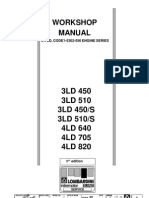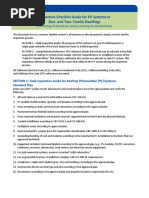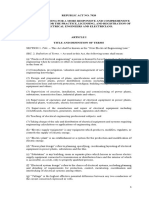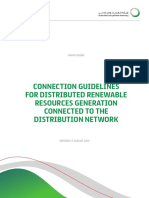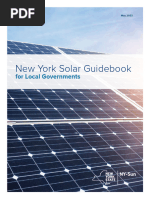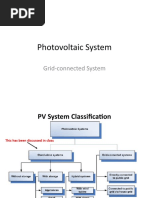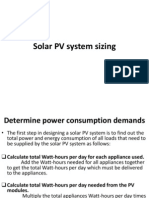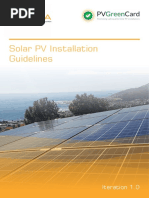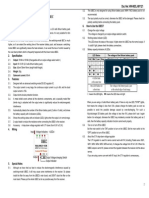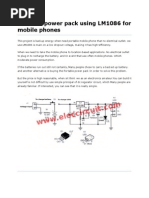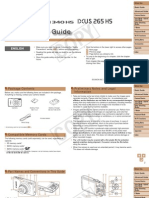PV Design and Installation Manual Ch1
PV Design and Installation Manual Ch1
Uploaded by
nico_brain10Copyright:
Available Formats
PV Design and Installation Manual Ch1
PV Design and Installation Manual Ch1
Uploaded by
nico_brain10Original Description:
Copyright
Available Formats
Share this document
Did you find this document useful?
Is this content inappropriate?
Copyright:
Available Formats
PV Design and Installation Manual Ch1
PV Design and Installation Manual Ch1
Uploaded by
nico_brain10Copyright:
Available Formats
SEI-ChaptersR.
qxd
5/5/04
4:57 PM
Page 1
Chapter 1
An Overview of Photovoltaics
Contents:
1.1
1.2
1.3
1.4
1.5
1.6
1.7
The Development of Photovoltaics . . . . . . . . . . . . . . . . . . . . . . . . 2
Current and Emerging Opportunities . . . . . . . . . . . . . . . . . . . . . . 2
Advantages of Photovoltaic Technology . . . . . . . . . . . . . . . . . . . . . 3
Disadvantages of Photovoltaic Technology . . . . . . . . . . . . . . . . . . . 3
Environmental, Health, and Safety Issues . . . . . . . . . . . . . . . . . . . 3
Photovoltaic System Components . . . . . . . . . . . . . . . . . . . . . . . . . 4
Photovoltaic System Types . . . . . . . . . . . . . . . . . . . . . . . . . . . . . . . 4
SEI-ChaptersR.qxd
5/5/04
4:57 PM
Page 2
PHOTOVOLTAICS: DESIGN AND INSTALLATION MANUAL
1.1
The Development of
Photovoltaics
Photovoltaic systems are solar energy systems that
produce electricity directly from sunlight.
Photovoltaic (PV) systems produce clean, reliable
energy without consuming fossil fuels and can be
used in a wide variety of applications. A common
application of PV technology is providing power for
watches and radios. On a larger scale, many utilities
have recently installed large photovoltaic arrays to
provide consumers with solar-generated electricity, or
as backup systems for critical equipment.
Research into photovoltaic technology began
over one hundred years ago. In 1873, British scientist
Willoughby Smith noticed that selenium was
sensitive to light. Smith concluded that seleniums
ability to conduct electricity increased in direct
proportion to the degree of its exposure to light. This
observation of the photovoltaic effect led many
scientists to experiment with this relatively
uncommon element with the hope of using the
material to create electricity. In 1880, Charles Fritts
developed the first selenium-based solar electric cell.
The cell produced electricity without consuming any
material substance, and without generating heat.
Broader acceptance of photovoltaics as a power
source didnt occur until 1905, when Albert Einstein
offered his explanation of the photoelectric effect.
Einsteins theories led to a greater understanding of
the physical process of generating electricity from
sunlight. Scientists continued limited research on the
selenium solar cell through the 1930s, despite its low
efficiency and high production costs.
In the early 1950s, Bell Laboratories began a
search for a dependable way to power remote
communication systems. Bell scientists discovered
that silicon, the second most abundant element on
earth, was sensitive to light and, when treated with
certain impurities, generated a substantial voltage. By
1954, Bell developed a silicon-based cell that
achieved six percent efficiency.
The first non-laboratory use of photovoltaic
technology was to power a telephone repeater station
in rural Georgia in the late 1950s. National
Aeronautics and Space Administration (NASA)
scientists, seeking a lightweight, rugged and reliable
energy source suitable for outer space, installed a PV
system consisting of 108 cells on the United States
first satellite, Vanguard I. By the early 1960s, PV
systems were being installed on most satellites and
spacecraft.
Today, over 200,000 homes in the United States
use some type of photovoltaic technology. Solar
modules contribute power to 175,000 villages in over
140 countries worldwide, producing thousands of jobs
and creating sustainable economic opportunities. In
2001, worldwide sales of photovoltaic products totaled
over 350 megawatts and over $2 billion in the global
market. The applications include communications,
refrigeration for health care, crop irrigation, water
purification, lighting, cathodic protection,
environmental monitoring, marine and air navigation,
utility power, and other residential and commercial
applications. The intense interest generated by current
photovoltaic applications provides promise for this
rapidly developing technology.
1.2
Current and Emerging
Opportunities
Conventional fuel sources have created myriad
environmental problems, such as global warming, acid
rain, smog, water pollution, rapidly filling waste
disposal sites, destruction of habitat from fuel spills,
and the loss of natural resources. Photovoltaic systems
do not pose these environmental consequences. Today,
the majority of PV modules use silicon as their major
component. The silicon cells manufactured from one
ton of sand can produce as much electricity as burning
500,000 tons of coal.
Photovoltaic technology also creates jobs. Solar
industries directly employ nearly 20,000 people and
support over 200,000 jobs in areas such as glass and
steel manufacturing, electrical and plumbing
contracting, architecture and system design, and
battery and electrical equipment manufacturing. By
some estimates, 3,800 jobs are created for every $100
million in PV sales.
The photovoltaic market grows each year.
Economists have predicted that photovoltaics will be
the most rapidly growing form of commercial energy
after 2030, with sales exceeding $100 billion. In fact,
the use of solar and renewable energy is expected to
double by the year 2010, which would create more
than 350,000 new jobs. It is no surprise that this
clean, reliable source of electric power is regarded as
the future of energy production.
Section 1.1 1.2
SEI-ChaptersR.qxd
5/5/04
4:57 PM
Page 3
PHOTOVOLTAIC ELECTRIC PRINCIPLES
1.3
Advantages of
Photovoltaic Technology
Photovoltaic systems offer substantial advantages
over conventional power sources:
Reliability. Even in harsh conditions,
photovoltaic systems have proven their
reliability. PV arrays prevent costly power
failures in situations where continuous
operation is critical.
Durability. Most PV modules available today
show no degradation after ten years of use. It
is likely that future modules will produce
power for 25 years or more.
Low Maintenance Cost. Transporting
materials and personnel to remote areas for
equipment maintenance or service work is
expensive. Since PV systems require only
periodic inspection and occasional
maintenance, these costs are usually less than
with conventionally fueled systems.
generator at higher altitudes must be de-rated
because of losses in efficiency and power
output.
1.4
Disadvantages of
Photovoltaic Technology
Photovoltaics have some disadvantages when
compared to conventional power systems:
Initial Cost. Each PV installation must be
evaluated from an economic perspective and
compared to existing alternatives. As the
initial cost of PV systems decreases and the
cost of conventional fuel sources increases,
these systems will become more economically
competitive.
Variability of Available Solar Radiation.
Weather can greatly affect the power output
of any solar-based energy system. Variations
in climate or site conditions require
modifications in system design.
No Fuel Cost. Since no fuel source is
required, there are no costs associated with
purchasing, storing, or transporting fuel.
Energy Storage. Some PV systems use
batteries for storing energy, increasing the
size, cost, and complexity of a system.
Reduced Sound Pollution. Photovoltaic
systems operate silently and with minimal
movement.
Efficiency Improvements. A cost-effective use
of photovoltaics requires a high-efficiency
approach to energy consumption. This often
dictates replacing inefficient appliances.
Photovoltaic Modularity. PV systems are
more cost effective than bulky conventional
systems. Modules may be added
incrementally to a photovoltaic system to
increase available power.
Safety. PV systems do not require the use of
combustible fuels and are very safe when
properly designed and installed.
Independence. Many residential PV users cite
energy independence from utilities as their
primary motivation for adopting the new
technology.
Electrical Grid Decentralization. Small-scale
decentralized power stations reduce the
possibility of outages on the electric grid.
High Altitude Performance. Increased
insolation at high altitudes makes using
photovoltaics advantageous, since power
output is optimized. In contrast, a diesel
Education. PV systems present a new and
unfamiliar technology: Few people
understand their value and feasibility. This
lack of information slows market and
technological growth.
1.5
Environmental, Health,
and Safety Issues
Electricity produced from photovoltaics is much
safer and more environmentally benign than
conventional sources of energy production. However,
there are environmental, safety, and health issues
associated with manufacturing, using, and disposing
of photovoltaic equipment.
The manufacturing of electronic equipment is
energy intensive. On the other hand, photovoltaic
modules produce more electricity in their lifetimes
than it takes to produce them. An energy break-even
point is usually achieved after three to six years.
As with any manufacturing process, producing
Section 1.3 1.5
SEI-ChaptersR.qxd
5/5/04
4:57 PM
Page 4
PHOTOVOLTAICS: DESIGN AND INSTALLATION MANUAL
photovoltaic modules often poses environmental and
health hazards. Workers may be exposed to toxic and
potentially explosive gases, such as phosphine,
diborane, hydrogen deselenide, and cadmium
compounds. Manufacturers have made steps to
minimize environmental and worker hazards by
implementing carefully designed industrial processes
and monitoring systems.
Safety for installation technicians is also a
concern. Only qualified personnel, using equipment
that complies with national safety standards, should
install photovoltaic systems.
The disposal of photovoltaic system components
poses a moderate environmental hazard. Most solar
modules have an expected useful life of at least 20
years. Most of the components can be recycled or
reused (for example, glass and plastic encasements,
and aluminum frames), but semiconductor recycling
is extremely limited.
1.6
Photovoltaic System
Components
Photovoltaic systems are built from several important
components:
Photovoltaic Cell. Thin squares, discs, or
films of semiconductor material that generate
voltage and current when exposed to
sunlight.
Module. A configuration of PV cells
laminated between a clear superstrate
(glazing) and an encapsulating substrate.
Panel. One or more modules (often used
interchangeably with module).
Array. One or more panels wired together at a
specific voltage.
Charge Controller. Equipment that regulates
battery voltage.
1.7
Photovoltaic
System Types
Photovoltaic systems can be configured in many
ways. For example, many residential systems use
battery storage to power appliances during the night.
In contrast, water pumping systems often operate
only during the day and require no storage device. A
large commercial system would likely have an
inverter to power AC appliances, whereas a system in
a mobile home would likely power only DC
appliances and wouldnt need an inverter. Some
systems are linked to the utility grid, while others
operate independently.
Integrated Photovoltaic Battery-Charging
Systems: These systems incorporate all their
components, including the application, in a single
package. This arrangement may be economical when
it compliments or replaces a disposable battery
system. Small appliances, complete with a
rechargeable battery and integrated PV batterychargers, are a common example. Solar lanterns and
photovoltaic chargers for radio batteries have
worldwide market potential. Kits for photovoltaic
flashlights, clocks, and radios may eventually replace
similar units that use expensive, wasteful, disposable
batteries.
Day Use Systems: The simplest and least
expensive photovoltaic systems are designed for day
use only. These systems consist of modules wired
directly to a DC appliance, with no storage device.
When the sun shines on the modules, the appliance
consumes the electricity they generate. Higher
insolation (sunshine) levels result in increased power
output and greater load capacity.
Examples of day use systems include:
Remote water pumping for a storage tank.
Battery Storage. A medium that stores direct
current (DC) electrical energy.
Operation of fans, blowers, or circulators to
distribute thermal energy for solar water
heating systems or ventilation systems.
Inverter. An electrical device that changes
direct current to alternating current (AC).
Stand-alone, solar-powered appliances such as
calculators and toys.
DC Loads. Appliances, motors, and
equipment powered by direct current.
AC Loads. Appliances, motors, and
equipment powered by alternating current.
Section 1.6 1.7
SEI-ChaptersR.qxd
5/5/04
4:57 PM
Page 5
PHOTOVOLTAIC ELECTRIC PRINCIPLES
12VDC
DC Pump
12VDC
PV Array
Figure
1-1
Day
Use System
figure
1-1
DAY USE SYSTEM
Direct Current Systems With Storage Batteries:
To operate loads at night or during cloudy weather, PV
systems must include a means of storing electrical
energy. Batteries are the most common solution. System
loads can be powered from the batteries during the day
or night, continuously or intermittently, regardless of
weather. In addition, a battery bank has the capacity to
supply high-surge currents for a brief period, giving the
system the ability to start large motors or to perform
other difficult tasks. A simple DC system that uses
batteries is illustrated in Figure 1-2. This systems basic
components include a PV module, charge controller,
storage batteries, and appliances (the systems electrical
load).
A battery bank can range from small flashlightsize batteries to dozens of heavy-duty industrial
batteries. Deep-cycle batteries are designed to
withstand being deeply discharged and then fully
recharged when the sun shines. (Conventional
automobile batteries are not well suited for use in
photovoltaic systems and will have short effective
lives.) The size and configuration of the battery bank
depends on the operating voltage of the system and
the amount of nighttime usage. In addition, local
weather conditions must be considered in sizing a
battery bank. The number of modules must be
chosen to adequately recharge the batteries during
the day.
Batteries must not be allowed to discharge too
deeply or be overchargedeither situation will
damage them severely. A charge controller will
prevent the battery from overcharging by
automatically disconnecting the module from the
battery bank when it is fully loaded. Most charge
controllers also prevent batteries from reaching
dangerously low charge levels by stopping the supply
of power to the DC load. Providing charge control is
critical to maintaining battery performance in all but
the simplest of PV systems.
Direct Current Systems Powering Alternating
Current Loads: Photovoltaic modules easily produce
DC electrical power, but many common appliances
require AC power. Direct current systems that power
12VDC
Charge Controller
Storage Battery
12VDC
DC Loads
12VDC
PV Array
DC System
with 1-2
Batteries
Figure
figure
1-2BATTERIES
DC SYSTEM
WITH
Section 1.7
SEI-ChaptersR.qxd
5/5/04
4:57 PM
Page 6
PHOTOVOLTAICS: DESIGN AND INSTALLATION MANUAL
12VDC120VAC
Charge Controller
Storage Battery
12VDC
12VDC
Branch Circuits
to DC Loads
PV Array
DC Load Center
12VDC
Inverter
Branch Circuits
to AC Loads
120VAC
AC Load Center
System with
DC and
Figure
1-3AC Loads
figure
1-3
SYSTEM WITH DC AND AC LOADS
AC loads must use an inverter to convert DC
electricity into AC. Inverters provide convenience
and flexibility in a photovoltaic system, but add
complexity and cost. Because AC appliances are
mass-produced, they are generally offered in a wider
selection, at lower cost, and with higher reliability
than DC appliances. High quality inverters are
commercially available in a wide range of capacities.
Utility Grid Interconnected Systems:
Photovoltaic systems that are connected to the utility
grid (utility-connected, grid-tie, or line-tie systems)
do not need battery storage in their design because
the utility grid acts as a power reserve. Instead of
storing surplus energy that is not used during the day,
the homeowner sells the excess energy to a local
utility through a specially designed inverter. When
homeowners need more electricity than the
photovoltaic system produces, they can draw power
from the utility grid. See figure 1-4.
If the utility grid goes down, the inverter
automatically shuts off and will not feed solargenerated electricity back into the grid. This ensures
the safety of linepersons working on the grid. Because
utility-connected systems use the grid for storage
these systems will not have power if the utility grid
goes down. For that reason, some of these systems are
also equipped with battery storage to provide power
in the event of power loss from the utility grid.
The Public Utilities Regulatory Policies Act
(PURPA) of 1978 requires electric utilities to
purchase power from qualified, small power
producing system owners. The utilities must pay the
small power producers based on their avoided
costs, or costs the utility does not have to pay to
generate that power themselves. Additional terms
and conditions for these purchases are set by state
utility commissions and vary from state to state.
While this law allows homeowners in areas with
utility power to purchase photovoltaic systems and
sell their excess power to an electric utility, people
contemplating doing so should remember that this is
rarely a profitable venture at the present time.
Some utility companies offer netmetering to
their customers, where a single meter spins in either
direction depending upon whether the utility is
providing power to the customer or the customer is
producing excess power. The customer or
independent power producer pays or collects the net
value on the meter. Net metering is very desirable to
the independent power producer because he/she can
sell power at the same retail rate that the utility
charges its customers.
Hybrid Systems: Most people do not run their
entire load solely off their PV system. The majority
of systems use a hybrid approach by integrating
another power source. The most common form of
hybrid system incorporates a gas or diesel-powered
engine generator, which can greatly reduce the initial
cost. Meeting the full load with a PV system means
the array and batteries need to support the load
Section 1.7
SEI-ChaptersR.qxd
5/5/04
4:57 PM
Page 7
PHOTOVOLTAIC ELECTRIC PRINCIPLES
Solar Power
AC to Grid
Solar PV Array
Grid-Tie Inverter
AC Utility Meter
Main Utility
Breaker Panel
DC Voltage
Input
AC Voltage
Output
Figure 1-4
Utility Grid Interconnected
System
figure
1-4?
UTILITY-INTERACTIVE SYSTEM WITHOUT BATTERIES
under worst-case weather conditions. This also
means the battery pack must be large enough to
power large loads, such as washing machines, dryers,
and large tools. A generator can provide the extra
power needed during cloudy weather and during
periods of heavier than normal electrical use, and can
also be charging the batteries at the same time. A
hybrid system provides increased reliability because
there are two independent charging systems at work.
Another hybrid approach is a PV system
integrated with a wind turbine. Adding a wind turbine
makes sense in locations where the wind blows when
the sun doesnt shine. In this case, consecutive days of
cloudy weather are not a problem, so long as the wind
turbine is spinning. For even greater reliability and
flexibility, a generator can be included in a PV/Wind
system. A PV/Wind/Generator system has all of the
advantages of a PV/Generator system, with the added
benefit of a third charging source for the batteries.
Section 1.7
You might also like
- NFPA 70 - Article 690 - Solar Photovoltaic (PV) SystemsDocument11 pagesNFPA 70 - Article 690 - Solar Photovoltaic (PV) SystemsBennyLowNo ratings yet
- Workshop Manual: 3LD 450 3LD 510 3LD 450/S 3LD 510/S 4LD 640 4LD 705 4LD 820Document33 pagesWorkshop Manual: 3LD 450 3LD 510 3LD 450/S 3LD 510/S 4LD 640 4LD 705 4LD 820Ilie Viorel50% (6)
- Testing of Solar InvertersDocument38 pagesTesting of Solar InvertersVignesh KumarNo ratings yet
- 2011 IIEE Magazine 4th Quarter - Magazine PDFDocument40 pages2011 IIEE Magazine 4th Quarter - Magazine PDFEng-Mohammed KayedNo ratings yet
- Operation and Maintenance of Solar PV SystemsDocument68 pagesOperation and Maintenance of Solar PV Systemssrinimeha@gmail.com33% (3)
- Photovoltaic EnergyDocument6 pagesPhotovoltaic EnergyKento FujimoriNo ratings yet
- Failure Modes For Flooded & VRLA BatteriesDocument46 pagesFailure Modes For Flooded & VRLA Batteriesazhagaan100% (1)
- Manual de Uso Altus Kinemtrics k2Document201 pagesManual de Uso Altus Kinemtrics k2JoRge BaRriosNo ratings yet
- Inspection Checklist Guide For PV Systems in One-And Two - Family DwellingsDocument7 pagesInspection Checklist Guide For PV Systems in One-And Two - Family DwellingsElectricité & Instrumentation Gassi Touil100% (1)
- Photovoltaic System Commissioning and Testing PDFDocument24 pagesPhotovoltaic System Commissioning and Testing PDFLeonardo Rojas Rapso100% (1)
- Inspecting PV Systems PDFDocument155 pagesInspecting PV Systems PDFElectricité & Instrumentation Gassi Touil100% (2)
- Nec 2017 Article690Document130 pagesNec 2017 Article690Director PQR CON18-74EC100% (2)
- Solar Installation ManualDocument13 pagesSolar Installation ManualShubham ArvikarNo ratings yet
- Solar PV Training DR. GEORGE SEPT.2020Document55 pagesSolar PV Training DR. GEORGE SEPT.2020PotatoFry100% (1)
- Electrical Installation WorkDocument19 pagesElectrical Installation WorkneocolloNo ratings yet
- Field Inspection Checklist For Rooftop Photovoltaic PV SystemsDocument2 pagesField Inspection Checklist For Rooftop Photovoltaic PV Systemsnino causapinNo ratings yet
- IIEE-SCC Solar PV System FundamentalsDocument70 pagesIIEE-SCC Solar PV System FundamentalsJoseph Ryan Manandeg100% (2)
- Solar Energy - Economic AnalysisDocument13 pagesSolar Energy - Economic AnalysisJayant Sisodia100% (1)
- Solar Installation and Operation ManualDocument20 pagesSolar Installation and Operation ManualAmal Mechanic100% (3)
- Cet l3 Fall 21 Solar System DesignDocument155 pagesCet l3 Fall 21 Solar System DesignOwais JawaidNo ratings yet
- First Solar 2014 Annual Report Bookmark - FinalDocument188 pagesFirst Solar 2014 Annual Report Bookmark - FinalFabián Orccón100% (1)
- Practical Operation Maintenance Manual On Solar PV SystemsDocument13 pagesPractical Operation Maintenance Manual On Solar PV SystemshoangbkNo ratings yet
- 6 5-B 4-4C F2C: Part V. Grounding and BondingDocument14 pages6 5-B 4-4C F2C: Part V. Grounding and BondingOmar KhatabNo ratings yet
- New Ee Law (Ra 7920)Document15 pagesNew Ee Law (Ra 7920)Kevin CabanteNo ratings yet
- Sizing and Cost Estimation Methodology For Stand Alone Residential PV Power SystemDocument20 pagesSizing and Cost Estimation Methodology For Stand Alone Residential PV Power SystemvenvettyNo ratings yet
- Guidelines For Protection Against Electric Shock in PV GeneratorsDocument9 pagesGuidelines For Protection Against Electric Shock in PV GeneratorsPablo di PasquoNo ratings yet
- Solar Energy: An Illustrated Dictionary ForDocument65 pagesSolar Energy: An Illustrated Dictionary ForMOUMMOUNo ratings yet
- PV Site Selection Survey 6Document6 pagesPV Site Selection Survey 6Luis ShamanNo ratings yet
- DRRG Connection Guidelines FinalDocument31 pagesDRRG Connection Guidelines Finalabhi_26t100% (1)
- Solar Photvoltaics: Dr.A.M.Surendra KumarDocument31 pagesSolar Photvoltaics: Dr.A.M.Surendra KumarHarish A.P.No ratings yet
- 2023 Solar GuidebookDocument247 pages2023 Solar GuidebookSamuel TesfayNo ratings yet
- Module Rec Solar ReferencesDocument22 pagesModule Rec Solar Referenceseltrance81No ratings yet
- Grid Connected Photovoltaic SystemDocument18 pagesGrid Connected Photovoltaic SystemAbu SalmanNo ratings yet
- Solar Electric Technician, Level-I SyllabusDocument28 pagesSolar Electric Technician, Level-I Syllabusrosan.sapkotaNo ratings yet
- Photovoltaic SoftwareDocument6 pagesPhotovoltaic Softwareroks143No ratings yet
- Ground Mount PV SolarDocument6 pagesGround Mount PV SolarJohn Kamau Khalfani100% (1)
- Handbook of Practical Electrical Design, 3rd Edition: IEEE Electrical Insulation Magazine December 1999Document2 pagesHandbook of Practical Electrical Design, 3rd Edition: IEEE Electrical Insulation Magazine December 1999James FitzGeraldNo ratings yet
- Sizing of PV SystemDocument6 pagesSizing of PV Systemmanu_ram1No ratings yet
- Solar PV Guidelines - Digital Spread High-ResDocument41 pagesSolar PV Guidelines - Digital Spread High-ResMichael Oyibo100% (2)
- 03-10-2011 110815 Photovoltaic-Application-GuideDocument20 pages03-10-2011 110815 Photovoltaic-Application-GuideMárcio CruzNo ratings yet
- Procedures For Solar Electric (Photovoltaic Abbreviated As PV) System Design and InstallationDocument5 pagesProcedures For Solar Electric (Photovoltaic Abbreviated As PV) System Design and InstallationVinit JhingronNo ratings yet
- Faults in Electrical Power SystemDocument4 pagesFaults in Electrical Power Systemmaruf048No ratings yet
- PDFDocument33 pagesPDFPaddy100% (1)
- Modeling and Simulations of Lightning Protection Photovoltaic ModulesDocument4 pagesModeling and Simulations of Lightning Protection Photovoltaic Modulesferdad4realNo ratings yet
- Guideline For Solar PV System Installation For ServiceProvidersDocument66 pagesGuideline For Solar PV System Installation For ServiceProvidersdharmapriyauss100% (2)
- PhotoVoltaic General CatalogDocument20 pagesPhotoVoltaic General CatalogBernardo Andrés GilardoniNo ratings yet
- Guidelines On Ee of Electrical InstallationsDocument45 pagesGuidelines On Ee of Electrical InstallationsAnonymous MDkp0hnb3lNo ratings yet
- Rooftop Solar Installation Guide For Tamil NaduDocument37 pagesRooftop Solar Installation Guide For Tamil NaduVignesh KumarNo ratings yet
- BUILDING SERVICES IIQuestion BankDocument37 pagesBUILDING SERVICES IIQuestion BankSiva Raman100% (1)
- Design Aspect of Standalone Solar PV SystemDocument20 pagesDesign Aspect of Standalone Solar PV SystemMalik SameeullahNo ratings yet
- Technological University (Kyaukse) Department of Electrical Power Engineerging (2017-2018) ACADEMIC YEARDocument27 pagesTechnological University (Kyaukse) Department of Electrical Power Engineerging (2017-2018) ACADEMIC YEARBo Tauk HteinNo ratings yet
- ContentsDocument10 pagesContentshqdNo ratings yet
- During This Oral We Will Talk To You About Photovoltaic Solar PanelsDocument3 pagesDuring This Oral We Will Talk To You About Photovoltaic Solar PanelsKency-Clovis ParavyNo ratings yet
- Solar PV Individual ReportDocument7 pagesSolar PV Individual ReportshathishNo ratings yet
- Significance of Solar InvertersDocument10 pagesSignificance of Solar Invertershedonist81No ratings yet
- Photovoltaics: An Initiative Step Towards Sustainable TechnologyDocument5 pagesPhotovoltaics: An Initiative Step Towards Sustainable TechnologyInternational Organization of Scientific Research (IOSR)No ratings yet
- Energy 507Document5 pagesEnergy 507Ofili ChukwunonsoNo ratings yet
- IJSDR1902043Document8 pagesIJSDR1902043Boutaina BoujradaNo ratings yet
- Solar PhotovoltaicsDocument45 pagesSolar PhotovoltaicsDarshan KhuntNo ratings yet
- Photovoltaics SummaryDocument4 pagesPhotovoltaics Summarymyownworks0No ratings yet
- Solar Electric Photovoltaic Modules Photovoltaic (PV) PowerDocument13 pagesSolar Electric Photovoltaic Modules Photovoltaic (PV) PowerJboar TbenecdiNo ratings yet
- Shathish Solar PVDocument7 pagesShathish Solar PVshathishNo ratings yet
- Datasheet UBECDocument1 pageDatasheet UBECjajang_elektro_untirtaNo ratings yet
- JMRC, Jaipur ReportDocument60 pagesJMRC, Jaipur ReportY.K. Maha WarNo ratings yet
- FM Fire Pump Inspection Checklist and FormDocument4 pagesFM Fire Pump Inspection Checklist and Formkrunalb@inNo ratings yet
- Effects of Extreme TemperaturesDocument3 pagesEffects of Extreme TemperaturesrajuanthatiNo ratings yet
- Caution: Dpu-414 Thermal Printer Safety PrecautionsDocument1 pageCaution: Dpu-414 Thermal Printer Safety PrecautionsAfrizal SetiawanNo ratings yet
- PC4010 v3.0 - Installation Manual: WARNING: This Manual Contains Information On LimitationsDocument52 pagesPC4010 v3.0 - Installation Manual: WARNING: This Manual Contains Information On LimitationsLuci LuciNo ratings yet
- Soil Test Resistance MeterDocument11 pagesSoil Test Resistance Meterjames_frankNo ratings yet
- Project of Electronics SubjectDocument14 pagesProject of Electronics SubjectDarren Troy Lingao MayorNo ratings yet
- WSH Guidelines Safe Operation of Forklift TrucksDocument19 pagesWSH Guidelines Safe Operation of Forklift TrucksAravind Appi RajNo ratings yet
- JNTU ANATHAPUR B.TECH Mechanical Engineering R09 SyllabusDocument147 pagesJNTU ANATHAPUR B.TECH Mechanical Engineering R09 Syllabuspavankumar72No ratings yet
- Ficha Tecnica Bateria Gel 6v 600ahDocument3 pagesFicha Tecnica Bateria Gel 6v 600ahdistri farmacosNo ratings yet
- D4B802CE070-ODIS Workbook PDFDocument21 pagesD4B802CE070-ODIS Workbook PDFandrew smith100% (1)
- 76 Nfpa 2020Document1 page76 Nfpa 2020firman hidayahNo ratings yet
- Hi-Pe: High Performance Walk-Through Multi-Zone Metal DetectorDocument6 pagesHi-Pe: High Performance Walk-Through Multi-Zone Metal DetectorKhaled ElSaeedNo ratings yet
- Alarm System - DSC Pc1555 - FaqDocument3 pagesAlarm System - DSC Pc1555 - Faqa7878736No ratings yet
- CyberPower Eps Series InfoguideDocument4 pagesCyberPower Eps Series InfoguideRodney Teopengco100% (1)
- Panasonic - NCR20700A Specification DatasheetDocument7 pagesPanasonic - NCR20700A Specification Datasheetmick.pride81No ratings yet
- Canon Ixus 265 HS ManualDocument163 pagesCanon Ixus 265 HS ManualMarcelo Peixoto Del PelosoNo ratings yet
- Basic Battery TestingDocument5 pagesBasic Battery TestingkriziameiahnNo ratings yet
- Ultra3 - Dakota MX3 - MDADocument2 pagesUltra3 - Dakota MX3 - MDAgreggles69No ratings yet
- Canon Powershot A400 Digital Camera SpecificationsDocument2 pagesCanon Powershot A400 Digital Camera SpecificationsrinahabibNo ratings yet
- MP75-MP150 Installation ManualDocument17 pagesMP75-MP150 Installation ManualMohamedGuerboujNo ratings yet
- Lorentz Pump ManualDocument16 pagesLorentz Pump ManualGirish OniyilNo ratings yet
- User Manual Spriometer Datsopir MicroDocument238 pagesUser Manual Spriometer Datsopir MicropitfalsamNo ratings yet
- Multi-Agent System For Managing A Power Distribution System With Plug-In Hybrid Electrical Vehicles in Smart GridDocument6 pagesMulti-Agent System For Managing A Power Distribution System With Plug-In Hybrid Electrical Vehicles in Smart GridsverdlowNo ratings yet
- Bowens Catalog 2013Document42 pagesBowens Catalog 2013Kevin SharpNo ratings yet
- Electronics and Wiring Diagram EPA13 Part 1 PDFDocument32 pagesElectronics and Wiring Diagram EPA13 Part 1 PDFIvan Valentić0% (1)

